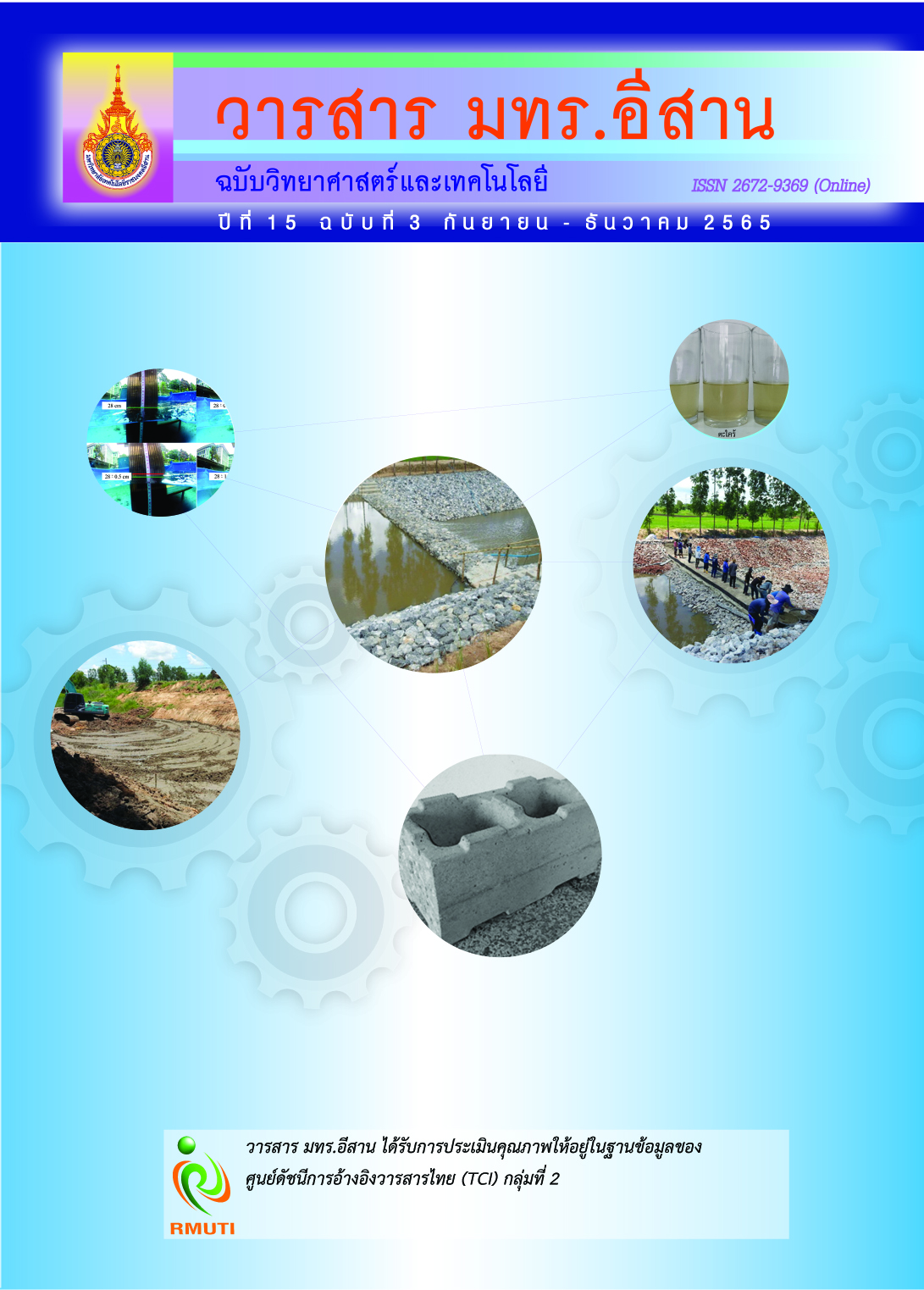ผลของชนิดสมุนไพรต่อฤทธิ์ต้านอนุมูลอิสระและคุณภาพทางประสาทสัมผัสของชากระวานผสมสมุนไพร
Main Article Content
บทคัดย่อ
ผู้บริโภคนิยมบริโภคชาสมุนไพรเพื่อต้องการฤทธิ์ทางยา และต้องการสัมผัสกลิ่นหอมและรสชาติที่ดีจากสมุนไพรชนิดนั้น ๆ ด้วย งานวิจัยนี้จึงมีวัตถุประสงค์เพื่อศึกษาผลของชนิดสมุนไพรที่มีต่อฤทธิ์ต้านอนุมูลอิสระและคุณภาพทางประสาทสัมผัสของชากระวานผสมสมุนไพร ในการทดลองนี้มีการผลิตชา 4 ชนิด ได้แก่ ชากระวาน ชากระวานตะไคร้ ชากระวานใบเตย และชากระวานชะเอมเทศ โดยชากระวานเตรียมได้จากผงใบกระวานผสมกับผงลำต้นกระวาน อัตราส่วน 1:1 และใช้สำหรับเป็นส่วนผสมในการผลิต ชากระวานผสมใบเตย ตะไคร้หรือชะเอมเทศ ในอัตราส่วน 1:1 นำซองชามาแช่ในน้ำร้อนอุณหภูมิ 90 oC 3 นาที แล้วนำน้ำชามาตรวจสอบพบว่า การผสมตะไคร้ ใบเตย หรือชะเอมเทศกับกระวาน ส่งผลให้สารประกอบฟีนอล ฟลาโวนอยด์ และฤทธิ์ต้านอนุมูลอิสระของชากระวานผสมสมุนไพรลดลงที่น่าสนใจพบว่า ชากระวานใบเตยได้รับคะแนนกลิ่น และความชอบโดยรวมสูงสุดในระดับชอบมากคือ 8.2 และ 8.2 คะแนน ดังนั้นใบเตยจึงเป็นสมุนไพรที่ควรนำมาใช้ร่วมกับกระวานในการผลิตชากระวาน โดยยังต้องพิจารณาสัดส่วนที่เหมาะสมที่มีผลต่อฤทธิ์ต้านอนุมูลอิสระ
Article Details

อนุญาตภายใต้เงื่อนไข Creative Commons Attribution-NonCommercial-NoDerivatives 4.0 International License.
เอกสารอ้างอิง
Sailaja Rao, P., Kalva, S., Yerramilli, A., and Mamidi, S. (2011). Free Radicals and Tissue Damage: Role of Antioxidants. Free Radicals and Antioxidants. Vol. 1, Issue 4, pp. 2-7. DOI: 10.5530/ax.2011.4.2
Choycharoen, P. (2021). Herb Tea: The Choice of Drinking Tea. Department of Clinical Chemistry, Faculty of Medical Technology, Huachiew Chalermprakiet University
Halliwell, B. (2007). Biochemistry of Oxidative Stress. Biochem Soc Trans. Vol. 35, Issue 5, pp. 1147-1150. DOI: 10.1042/BST0351147
Halee, A. and Rattanapun, B. (2017). Study of Antioxidant Efficacies of 15 Local Herbs. KMUTT Research and Development Journal. Vol. 40, No. 2, pp. 283-293 (in Thai)
Winarsi, H., Sasongko, N. D., Purwanto, A., Arinton, I. G., and Nuraeni, I. (2012). In Vitro Antioxidant Activity of the Stem and Leaves Amomum Cardamomum Extracts. In International Conference on Medicinal Plants, October 11-12. Universitas Jenderal
Soedirman, Purwokerto, Indonesia
Trinantawan, S. (2010). Cardamom. Access (8 April 2021). Avialable (https://www.scimath.org/article -biology/item/495-amomum-krervanh-pierre) (in Thai)
Attajaydee, A. (2007). Local Plants: Chanthaburi Food. Chanthaburi: Tonchabub Publishers (in Thai)
Kanenock, S. (2013). Development of Namwa Banana Peel Tea for Health. Research Report. Phranakhon Si Ayutthaya Rajabhat University, Ayutthaya (in Thai)
Inchuen, S., Simla, S., Phianjam, P., and A-sanok, P. (2017). Color and Antioxidant Property of Caranda (Carissa carandas L.) Leaves Tea as Affected by Leaf Positions and Tea Processing. Khon Kaen Agriculture Journal. Vol. 45, Supplement 1, pp. 1247-1252 (in Thai)
Joomwong, A. and Ketdee, W. (2020). Effects of Brewing Time Period on Physical and Chemical Quality, Antioxidant Activity and Sensory Quality of Gynostemma pentaphyllum Tea. Agriculture and Technology Journal. Vol. 1, No. 1, pp. 26-36 (in Thai)
Thai Industrial Standards Institute. (2015). Thai Community Product Standard (TCPS 120/2558; Tea). Thai Industrial Standards Institute, Ministry of Industry (in Thai)
Waterman, P. G. and Mole, S. (1994). Analysis of Phenolic Plant Metabolites. Oxford: Blackwell Scientific Publishers
Pourmorad, F., Hosseinimehr, S. J., and Shahabimajd, N. (2006). Antioxidant Activity, Phenol and Flavonoid Contents of Some Selected Iranian Medicinal Plants. African Journal of Biotechnology. Vol. 5, No. 11, pp. 1142-1145
Yen, G. C. and Hsieh, G. L. (1997). Antioxidand Effect on Dopamine and Related Compounds. Bioscience, Biotechnology and Biochemistry. Vol. 61, Issue 10, pp. 1646-1649. DOI: 10.1271/bbb.61.1646
Rice-Evans, C. A., Miller, N. J., and Paganga, G. (1997). Antioxidant Properties of Phenolic Compounds. Trends in Plant Science. Vol. 2, Issue 4, pp. 152-159. DOI: 10.1016/S1360-1385(97)01018-2
Huang, W. Y., Cai, Y. Z., and Zhang, Y. (2010). Natural Phenolic Compounds from MedicinalHerbs and Dietary Plants: Potential Use for Cancer Prevention. Nutrition and Cancer. Vol. 62, Issue 1, pp. 1-20. DOI: 10.1080/01635580903191585
Taokaenchan, N., Areseesom, P., and Kawaree, R. (2018). Antioxidant Activities and Sensory Acceptability of Herbal Tea of Caesalpinia sappan L. Obtained by Different Infusion Processes. Science and Technology Journal. Vol. 26, No. 8, pp. 1411-1421 (in Thai)
Vision, J. A., Dabbagh, Y. A., Serry, M. M., and Jang, J. (1995). Plant Flavonoid Especially Tea Flavonoid are Powerful Antioxidants Using an in Vitro Oxidation Model for Heart Disease. Journal of Agricultural and Food Chemistry (USA). Vol. 43, Issue 11, pp. 2800-2802. DOI: 10.1021/jf00059a005
Winarsi, H., Susilowati, S. S., and Oentoro, H. (2018). Composition of Functional Drinks Based on Cardamom Rhizomes (Amomum cardamomum Willd.) and the Benefits as an Anti-inflammatory with an Improved Lipid Profile. Pakistan Journal of Nutrition. Vol. 17, Issue 6, pp. 274-286. DOI: 10.3923/pjn.2018.274.286
Kaewamatawong, R. and Juengmankong, S. (2006). Antioxidant Activities, DPPH and Total Phenol Content of Some Thai Medicinal Plant Extracts. Ubon Ratchathani University Academic Journal. Vol. 8, No. 2, pp. 76-88 (in Thai)
Koodkaew, I. and Limpichotikul, P. (2017). Study of Antioxidant Activity and Correlation of Antioxidant Compounds in Eight Species of Garden Herbs. SDU Research Journal Science and Technology. Vol. 10, No. 1, pp. 137-152
Singsai, K., Sakdavirote, A., Wechpanishkitkul, K., and Moonsamai, A. (2020). The Comparison of Phenolic Compounds, Flavonoids and Antioxidant Activities of the Ethanolic Extracts of Shoots, Leaves, Fruits and Seeds of Leucaena leucocephala. Naresuan Phayao Journal Health Science, Science and Technology. Vol. 13, No. 3, pp. 66-73
Laksanalamai, V. and Ilangantileke, S. (1993). Comparison of Aroma Compound (2-acetyl-1-pyrroline) in Leaves from Pandan (Pandanus amaryllifolius) and Thai Fragrant rice (Khao Dawk Mali 105). Cereal Chemistry. Vol. 70, No. 4, pp. 381- 384


